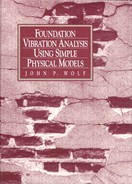0%
16Chapters
0-1Hours read
0kTotal Words
Book Description
This book provides simple physical models to represent the unbounded soil in time and frequency domain analysis. They do not supplant the more generally applicable rigorous methods, but rather supplement them. The physical models used consists of the following representations: cones based one-dimensional rod theory; lumped-parameter models with frequency-independent springs, dashpots, and masses; and prescribed wave patterns in the horizontal plane. The physical models thus offer a strength-of-materials approach to foundation dynamics.
Table of Contents
- Copyright
- Foreword
- Preface
- List of Tables for Lumped-Parameter Models
- 1. Introduction
- 2. Foundation on Surface of Homogeneous Soil Halfspace
- 2.1. Construction of Cone Model
- 2.2. Translational Cone
- 2.2.1. Stiffness Formulation
- 2.2.2. Flexibility Formulation
- 2.2.3. Example for Hand Calculation
- 2.2.4. Vibration of Machine Foundation
- Crank mechanism of reciprocating machine
- Dynamic load of single-cylinder compressor
- Dynamic load of weaver’s loom
- Design criterion
- Rigid foundation block
- Soil
- Dynamic system
- Stiffness formulation in time domain
- Flexibility formulation in time domain
- Stiffness formulation for harmonic loading
- Alternative descriptions for harmonic motion
- 2.3. Rotational Cone
- 2.3.1. Stiffness Formulation
- 2.3.2. Flexibility Formulation
- 2.3.3. Example for Hand Calculation
- 2.3.4. Vibration of Machine Foundation
- Dynamic load of three-cylinder compressor with cranks at 120°
- Design criterion
- Rigid foundation block
- Soil
- Uncoupled dynamic system with rocking motion only
- Uncoupled stiffness formulation in time domain
- Uncoupled stiffness formulation for harmonic loading
- Dynamic system with coupling of rocking and horizontal motions
- Coupled stiffness formulation in time domain
- Coupled stiffness formulation for harmonic loading
- Dynamic system of torsional motion
- 2.4. Material Damping
- 2.5. Why a Cone Model Can Represent the Elastic Halfspace
- 2.6. Simple Lumped-Parameter Models
- 2.7. Translational and Rocking Wedges
- 2.8. Insight on Two-Dimensional Versus Three-Dimensional Foundation Modeling
- 2.8.1. Object
- 2.8.2. Equivalent Slice of Two-Dimensional Strip Foundation with Same Material Properties
- 2.8.3. Alternative Equivalent Slice of Two-dimensional Strip Foundation Adjusting Impedance
- 2.8.4. Dynamic-Stiffness Coefficients of Disk and Equivalent Slices of Strips
- 2.8.5. Decay of Waves
- 2.8.6. Row of Point Loads
- 2.8.7. Square Versus Slender Rectangular Foundations
- Summary
- 3. Foundation on Surface of Soil Layer on Rigid Rock
- 3.1. Construction of Unfolded Layered Cone Model
- 3.2. Flexibility Formulation
- 3.3. Stiffness Formulation
- 3.4. Alternative Order of Realization
- 3.5. Illustrative Example
- 3.6. Soil Layer on Flexible Rock Halfspace
- 3.7. Basic Lumped-Parameter Model
- 3.8. Cutoff Frequency
- Summary
- 4. Embedded Foundation and Pile Foundation
- 4.1. Embedded Disk with Double-Cone Model and Its Green’s Function
- 4.1.1. One-Sided Cone
- 4.1.2. Double Cone
- 4.1.3. Embedded Disk with Anti-Symmetric and Symmetric Mirror Disks To Model Free Surface and Fixed Boundary of Halfspace
- 4.1.4. Embedded Disk with Anti-Symmetric and Symmetric Mirror Disks To Model Free Surface and Fixed Boundary of Layer
- 4.1.5. Embedded Disk with Mirror Disk to Model Interface with Halfspace
- 4.2. Matrix Formulation for Harmonic Loading of Foundation Embedded in Halfspace
- 4.3. Matrix Formulation in Time Domain of Foundation Embedded in Halfspace
- 4.4. Foundation Embedded in Layer
- 4.5. Limitation of Single Cone Model
- 4.6. Fundamental Lumped-Parameter Model for Foundation Embedded in Halfspace
- 4.7. Basic Lumped-Parameter Model for Foundation Embedded in Layer
- 4.8. Single Pile
- 4.9. Pile Group
- Summary
- 4.1. Embedded Disk with Double-Cone Model and Its Green’s Function
- 5. Simple Vertical Dynamic Green’s Function
- 5.1. Green’s Function of Point Load on Surface of Halfspace
- 5.2. Solutions Derived via Point-Load Green’s Function
- 5.3. Approximate Green’s Function of Disk
- 5.4. Matrix Formulation of Surface Foundation with Arbitrary Shape Modeled with Subdisks
- 5.5. Example of Square Surface Foundation
- 5.6. Through-Soil Coupling of Surface Foundations
- Summary
- 6. Seismic Excitation
- 6.1. Basic Equation of Motion of Substructure Method
- 6.2. Free-Field Response of Site
- 6.3. Effective Foundation Input Motion
- 6.4. Surface Foundation Modeled with Cones and Unfolded Cones
- 6.5. Foundation Modeled with Lumped-Parameter Model
- 6.6. Basic Equation of Motion of Direct Method
- Summary
- 7. Dynamic Soil-Structure Interaction
- A. Interaction Force-Displacement Relationship and Green’s Function of Cone Model
- B. Consistent Lumped-Parameter Model
- C. Recursive Evaluation of Convolution Integral
- D. Dynamic Stiffness of Foundation on or Embedded in Layered Soil Halfspace
- References
